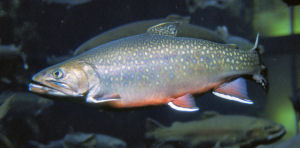Front Porch Blog
By Adam Reaves
Riverfest/Development intern, 2011
This latest Creature Feature highlighting NC’s native trout species is the Brook trout. To learn more about native aquatic critters in the area, don’t miss RiverFest on June 4th.
Throughout the Southern expanse of the Appalachian Mountains, the Brook trout spends its seven-year lifespan hunting for mollusks, insects, and frogs in cold streams, lakes and ponds. The Brook trout, sometimes known as the speckled trout or squaretail, is the only native trout species in the Appalachian Mountains and has been at the center of many natural resource management agencies’ efforts to preserve trout stocks.

According to a study conducted by the North Carolina Wildlife Resources Commission, 92,000 resident and non-resident anglers in the High Country contributed over $150 million to the North Carolina economy. Anglers and environmentalists both have an interest in preserving the health and integrity of the trout population.
The Brook Trout in particular, highlights many complex environmental issues and how they will affect the High Country in the future.
Most of the Brook trout’s natural habitat was destroyed during the twentieth century due to poor logging practices and acid rain, which have altered the pH balance of Appalachian streams. As environmental conditions improved after the Clean Water Act and similar legislation at the state level, non-native Rainbow and Brown trout were introduced to replenish the trout stocks. However, these non-native species outcompete the Brook trout for resources and even feed on the Brook trout’s young.
In an effort to preserve the Brook trout populations, hatcheries cultivated Brook trout in the Northeast and replenished the Southern Appalachian stock. However, unknown to agencies and scientists at the time, the Northeastern Brook trout are genetically distinct from their Southern cousins. Thus, another non-native specie was unwittingly introduced into the Brook trout’s environment.
The Brook trout currently occupies just one-forth of its original habitat. Future environmental changes will certainly reduce its population and range even further. The Brook trout depends on the cold, well-oxygenated water of the Southern Appalachian Mountains, as do many other species of wildlife. The impending loss of Eastern Hemlock stands to the Wooly Adelgid will certainly endanger the Brook trout and most other trout species in our area. As the tallest trees in Appalachians, the Hemlocks’ shade is vital to maintaining the cold temperature of mountain streams. Furthermore, wildlife agencies are studying the environmental and economic impacts of global climate change. They hope to understand how sensitive species, like the Brook trout, will respond to rising temperatures and exponentially increasing pollution.
Since the last glacial period some 10-15 thousand years ago, the green and brown marbled Brook trout has survived in these pristine mountain streams. Today, High Country residents can see how this unassuming fish connects the environment to the economy as well as local issues to regional and global issues. It’s striking how much one single fish can bring into focus. The destructive capacity of careless human industrial activity is a lesson we are continually relearning. Yet, even good-intentioned efforts toward preservation can further damage the environment if these efforts are not pursued with the upmost caution. Perhaps the next time you see one of these fish swimming by, you will consider the complexity and certainly, the beauty of the Appalachian Mountains.
PREVIOUS
NEXT
Related News

Leave a comment
Your email address will not be published. Required fields are marked *
